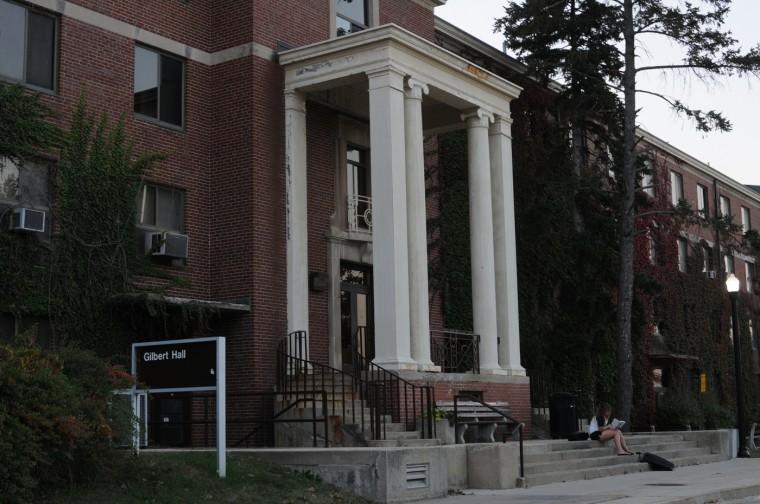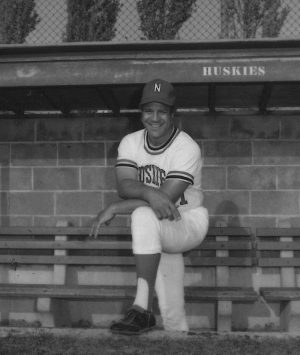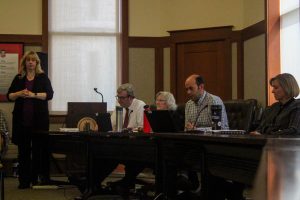Gilbert Hall Revisited
February 27, 2011
DeKALB | It’s 1995. Jeff Iwinski, sophomore marketing major and treasurer of Gilbert Hall Council, sits with NIU then-President John La Tourette in a large conference room in Lowden Hall, the Altgeld of its time.
Iwinski is surrounded by upper-level NIU administrators, and he asks them to meet his demands.
His demands are simple. And they can be heard permeating the walls of Lowden from the chants of over 200 student protestors below: “Save Gilbert Hall!”
Mr. Iwinski, your demands have been met, but about 18 years too late for you to enjoy them: Gilbert will reopen as a residence hall for fall semester 2013.
Student Uproar
The controversial shutting of Gilbert’s doors in 1995 on its nearly 300 residents was announced, much like the news of its reopening, after years of lingering rumors.
The reason for the closure was the need for “swing space” for faculty and staff displaced by the renovation of Altgeld Hall, said Eddie Williams, executive vice president for Business and Finance and chief of operations, in a Feb. 2, 1995 Northern Star article. Williams was then vice president of finance and planning.
Alumnus Patrick Krook, a Gilbert Hall resident at the time, said students were upset about the closure and unwilling to compromise.
In the article, students made it known they were upset with the administration.
Kimberly Kryger, then junior early childhood education major, said Gilbert’s closing made her want to transfer schools.
“If I am given preferential housing, I want to live under La Tourette’s deck,” said John Vos, then junior elementary education major.
Barbara Henley, then vice president for Student Affairs, said the administration understood that students would be inconvenienced, but she felt that, in the long run, they would be better served by faculty who had “quality space.”
In a Feb. 6, 1995 Northern Star article, Iwinski said, “Gilbert would be the professors’ nine-to-five office, but to us, it’s our home.”
Today, Iwinski is more forgiving.
“I look at it now as a rational business person and I say, ‘Yeah…they weren’t going to make their faculty walk across campus,'” Iwinski said. “They really had no choice. They had all this need for office space. The only building they could take it from was Gilbert.”
Krook said he still feels Gilbert didn’t have to close.
“They could have done the Altgeld remodeling in a different way to move things within the same facility,” he said. “They just chose to do it this way.”
A ‘Special’ Residence Hall
Iwinski said the amenities in Gilbert Hall were “bare bones;” it was the atmosphere that made the residence hall the best place to live at NIU.
Krook wrote in a Feb. 3, 1995 Northern Star letter to the editor that Gilbert was more than a home as “NIU’s Walden Pond,” a place for students to learn and grow with each other.
“Gilbert was special because the people there had community,” he said, “It was not just…conveniently located, it was a community of common interest.”
The residence hall provided a short walk for art, music and business students who attended classes in academic buildings on the east side of campus, but the hall also attracted a mix of students of all different ages and interests, Iwinski said.
“It was unlike most other residence halls,” he said. “It had a good mixture of age groups, freshmen to seniors, a lot of different types of kids: folks like me coming out of high school, preppy jocks, music groups, all the art students.”
Krook, who was a geography major, said he enjoyed that Gilbert was on the older and more historical side of campus.
“That was the allure of Gilbert Hall: it was ensconced in the old part of the university,” he said. “You had nice buildings and architecture all around you. The Gilbert Hall rally accentuated that there are two campuses at NIU: the old ivy [part] and the concrete slab deal.”
The Rally To Lowden
Iwinski said he hadn’t expected to rally a crowd of hundreds of students to march on NIU administrators on the steps of Gilbert Hall’s main entrance, but it was suggested by Bill Casey, then president of Gilbert Hall Council and a non-traditional student in his late 20s,
“I think he wanted to have a young face to it, for whatever reason,” Iwinski said. “He basically said, ‘Hey, why don’t you get up on the stairs and lead the rally?'”
Iwinski said he and other students had chalked messages about the rally and in support of keeping Gilbert open as a residence hall on sidewalks the night before.
“We expected hardly anything, [that] 20 or 30 people would come out and listen to what we had to say,” he said. “Being a college campus, people march around a building for pretty much anything.”
Krook, who also spoke on the steps of Gilbert that day, said he was also impressed by the turnout.
“The rally was attended by most everybody that lived there that wasn’t in class and some people who didn’t want to be in class,” Krook said.
Under a banner over Gilbert’s main entrance reading, “Don’t close our home,” and to the blasting of Nine Inch Nails’ “Terrible Lie,” students started their protest march to Lowden Hall, Iwinski said.
Students carried signs that said “Save Gilbert,” and “Hell no, we won’t go,” according to a Feb. 6, 1995 Northern Star article.
“Coming from a die-hard Republican from Naperville, that was pretty much my radical moment in life,” Iwinski said.
A Lost Cause and Moving On
Iwinski said the rally was exciting but a lost cause from the start.
“I think we pretty much knew that was going to be the case,” he said. “We kept up a good fight for a couple of weeks, but after that, I think people decided, ‘Hey, this isn’t going to happen. Let’s go back to our studies and having fun.'”
Students started the fight to save Gilbert by presenting a petition with 468 signatures to La Tourette and other senior NIU administrators, according to a Feb. 1, 1995 Northern Star article.
After the rally to Lowden, students continued to fight for Gilbert throughout the rest of the semester through talks with the administration, efforts within the Student Association and another rally.
Krook agrees that the students didn’t stand a chance.
“It was considered an inevitability,” he said. “There was never a discussion with the students about it until it was a foregone conclusion. That’s the way change always occurred on campus…[They] let people know when it was too late to affect outcome or explore other options.”
After Gilbert closed, Iwinski said he and several friends moved out to University Plaza and ended up enjoying the increased freedom far from the watch of a resident adviser.
Gilbert, Present and Future
Today, a web of orange rust creeps across the white paint of Gilbert’s east-facing main entrance. The white paint is chipped and peeling in places on its 30-foot white pillars, and plywood covers a first-story window nearby.
Yellow caution tape blocks off half of the stairs leading to the very place Krook and Iwinski stood one February afternoon in 1995.
Krook, who is now the CEO of an Internet company that brokers classic and collectible muscle cars, took note of Gilbert’s state when he visited his alma mater recently.
“We were back at the campus, visiting over New Years, and the residence hall didn’t look all that great,” he said.
Much of Gilbert is now unused; it houses several offices tucked away in winding basement hallways. The first, second and third levels are full of vacant rooms where students used to live.
Brian Hemphill, vice president for Student Affairs and Enrollment Management, said in a Dec. 2 Northern Star article that Gilbert Hall is being reopened to bring life back to the east side of campus and because Gilbert is an exact replica of Neptune North, the most popular residence hall among students.
Krook said he is glad Gilbert is opening again and students’ wishes are being addressed.
“It’s nice that it wasn’t forgotten,” he said. “It’s really nice to know that it’s being re-examined and that there is some institutional memory about what students [wanted].”
Planning for Gilbert is in the design phase this semester, but many renovations will need to be made to update its systems and add amenities to make it livable again, Hemphill said.
He said he has not determined which student population Gilbert Hall will be directed toward, but it will be offered to upper-class students.
Iwinski, who now works as a market researcher for Sara Lee, said he thinks it would be beneficial if the administration could find a way to create the same diversity in student population he experienced when he lived in Gilbert.
“It was a weird mix of people that worked,” he said, “If they could figure out a way to make that happen, that would be cool.”
It’s too late for Krook, Iwniski or any of the hundreds of student protestors to make Gilbert their home again. But a new generation of NIU students may find the same passion that inspired those who came before them to rally to “Save Gilbert Hall.”
It’s 2011. And Gilbert Hall has been saved.







